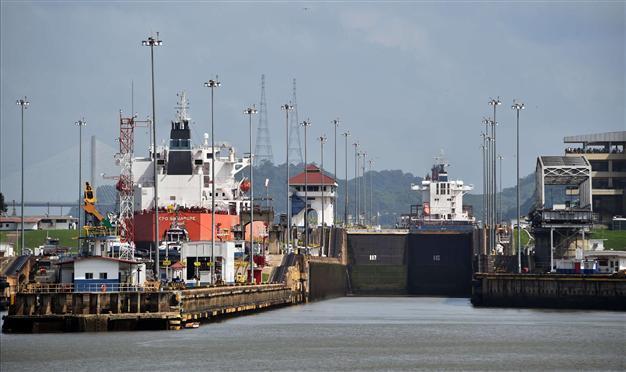Panama Canal turns 100 facing 21st-century problems
PANAMA CITY - Agence France-Presse

View of the Miraflores Locks at the Panama Canal on July 31, 2014. AFP Photo
The Panama Canal, one of the 20th century's greatest engineering triumphs, celebrates 100 years Friday, facing competition from rival projects and delays in the expansion aimed at ensuring its 21st-century relevance.
The product of decades of failed efforts and a final 10 years of breakneck construction that confirmed the United States as a major world power, the canal opened on August 14, 1914 with the passage of the steamship Ancon.
One hundred years later, more than a million ships have crossed the 80-kilometer canal, which today handles five percent of the world's maritime trade.
As early as the 1500s, Holy Roman Emperor Charles V had proposed uniting the Atlantic and Pacific Oceans with a canal across Central America to avoid the long, treacherous passage around the southern tip of South America.
France first tried to make that vision a reality, launching a massive project in 1880 led by engineer Ferdinand de Lesseps, who developed the Suez Canal in Egypt but failed to conquer the tropical diseases, engineering shortfalls and financial problems that beset his Panama attempt.
The United States took over in 1904, after sending warships to back Panama's secession from Colombia and signing a treaty with the newly independent country for control over the 16-kilometer-wide strip of land that would become known as the Canal Zone.
With cutting-edge engineering and the gruelling manual labor of tens of thousands of workers, the US completed the project in 10 years, transforming the geostrategic landscape just as World War I began ravaging Europe.
In all, an estimated 27,000 workers from around the world died building the canal, mostly of malaria and yellow fever.
The United States controlled the waterway for most of the 20th century, fueling Latin American resentment at being considered America's backyard.
In 1977, US president Jimmy Carter and his Panamanian counterpart Omar Torrijos signed a treaty handing the canal over to Panama on December 31, 1999 -- though the US retains the right to send in its military if it believes the waterway's neutrality is threatened.
Operating the canal has been a boon for Panama, bringing in about $1 billion a year -- 10 percent of the government's revenues and six percent of the national economy.
The canal provides 10,000 jobs and has helped make Panama one of the most dynamic economies in the region, with 8.4 percent growth last year.
"For Panama, the canal has meant progress," its current administrator, Jorge Quijano, told AFP.
"We were transformed from a forgotten province (of Colombia) into an independent state that could choose its future."
But Panama also faces growing competition from rivals.
The Suez Canal has larger capacity and is cutting into the Panama's share of global shipping traffic, which has "slowly sapped our revenues," said Quijano.
Egyptian President Abdel Fattah al-Sisi recently launched the construction of a $4 billion "new Suez Canal" running parallel to the original that aims to accelerate traffic and sharpen its competitive edge.
Closer to home, Nicaragua, which fought Panama more than a centry ago to host the first canal across Central America, has reemerged as a modern-day rival.
The country has granted a 50-year concession to Chinese businessman Wang Jing to build and operate a canal that would have larger capacity than Panama's and be able to handle modern mega-freighters too big for its rival's current dimensions.
Last month Nicaragua finalized the route for the $40 billion project, which Wang's HK Nicaragua Canal Development Investment Co. (HKND) wants to complete in five years.
To fend off the competition, Panama is adding wider locks and channels to nearly triple its canal's capacity.
The expansion will allow it to handle so-called "Post-Panamax" ships with a capacity of 12,000 containers, instead of the current maximum of 5,000.
But the hugely ambitious project has been plagued by delays, strikes and a bitter dispute over $1.6 billion in cost overruns with the consortium of companies carrying out the upgrade.
The expansion was initially scheduled for completion this year, but has now been pushed back to January 2016.
Panamanian officials say it will eventually triple the government's annual revenues from the canal.
